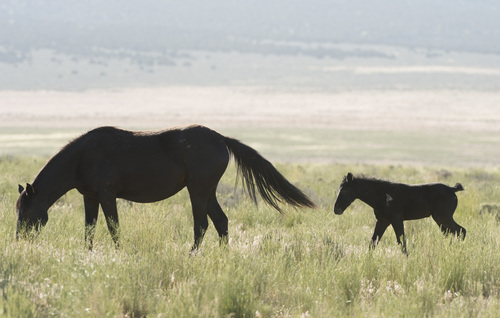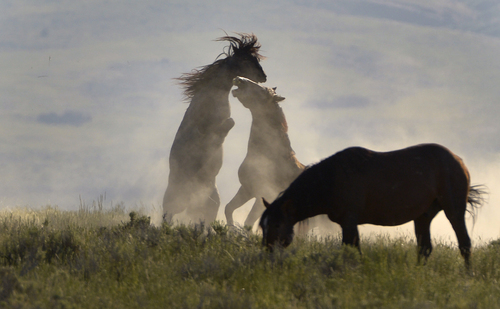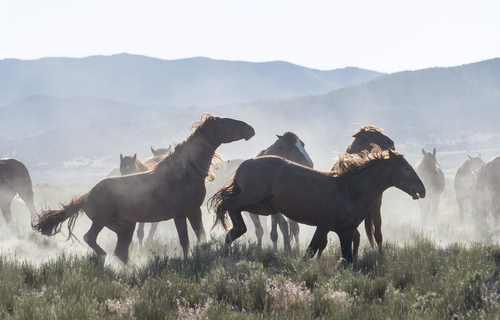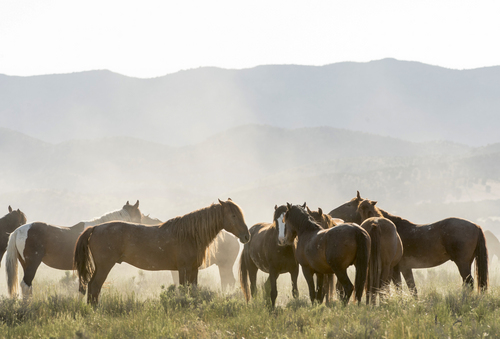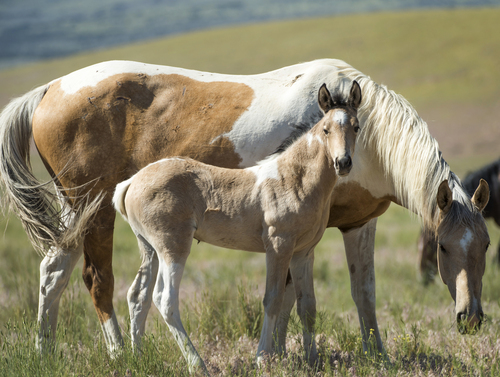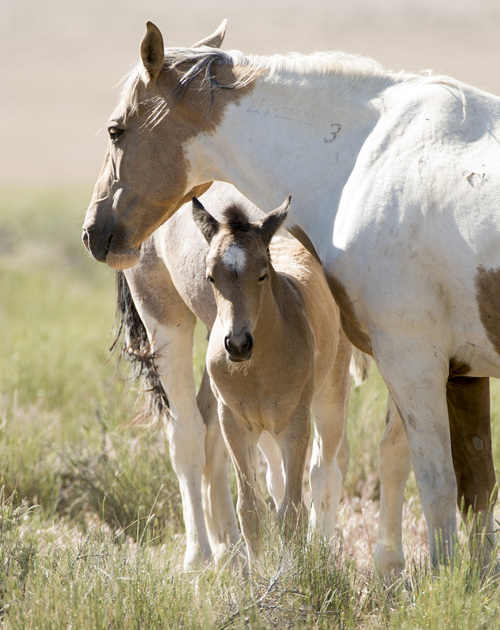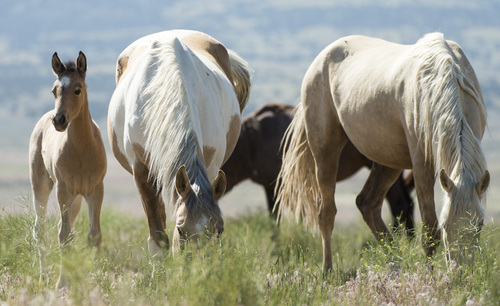This is an archived article that was published on sltrib.com in 2014, and information in the article may be outdated. It is provided only for personal research purposes and may not be reprinted.
Simpson Mountains • A herd of wild horses grazes amid sagebrush and knee-high clumps of grass along the path Pony Express riders rode through southern Tooele County.
Foals lie beneath their mothers, stallions pester the mares and every little while, a quarrel erupts and studs rear up, slam their front hooves down and try to bite each other.
Accustomed to visitors with cameras, these 100 mustangs do not run when humans come near.
Their ease with interlopers makes this herd a perfect candidate for a kind of birth control that involves shooting the mares in the rump with a dart gun.
And that's exactly what the Bureau of Land Management in Utah proposes to do next winter with the estimated 130 mares of the Onaqui herd, which ranges over 323 square miles between the Onaqui Mountains east of Dugway Proving Ground and the Simpson Mountains to the south of the Army base.
If approved after an environmental assessment, the fertility control effort will be the second one undertaken in the herd, which, like a sister herd 40 miles to the northwest in the Cedar Mountains, were vaccinated against pregnancy in the winter of 2012.
These efforts are important, even if they are a tiny piece of solving what has become a huge problem for the federal land agency: herds that double in size every four years.
Utah has 4,300 wild horses this year, double the number the BLM believes there should be on the range, says Gus Warr, who takes the lead on horses and burros for the BLM in Utah. "We could easily be at 5,000-plus animals next year," he says.
The problem is mirrored in nine other Western states. Altogether, there are 49,000 wild horses and burros on ranges that should have less than 27,000, according to the BLM, which is charged with managing public land for recreation, resource development, wildlife and livestock as well as for horses.
—
'Use the tools you have' • The old way of thinning the herds — rounding up horses, and trucking those that no one adopts to long-term pastures in the Midwest — is fast fading as an option.
The BLM spent 64 percent of its $72 million budget last year taking care of 50,000 pastured wild horses, and a study commissioned by the agency found those removals are only making the situation worse.
Horse populations grow faster when there's less competition for forage and water, according to the report, released a year ago by a research panel at the National Academy of Sciences.
"They are up against a wall. They are running out of options," says Stephanie Boyles Griffin, senior director of innovative wildlife management for the Humane Society of the United States.
The animal welfare organization has teamed with the BLM since 2008 to study fertility control in the Cedar Mountain herd as well as the Sand Wash herd in Colorado, and it is slowing population growth. The Annenberg Foundation is helping fund the research.
Only 5 percent of the Cedar Mesa mares that were first vaccinated in 2008 and given a booster in 2012 had foals last year, Griffin says.
The NAS report strongly urged the BLM to embrace fertility control — and give up removals — and pointed to the benefits of porcine zona pellucida (PZP), which is being used on the Onaqui and Cedar Mountain herds.
The BLM has been slow to adopt contraception — though, at times, it has promised to do so — in part because it has been holding out for one that will work for five or more years.
The Environmental Protection Agency in 2012 approved the most common vaccine that uses PZP, Zonastat-H, but mares have to be vaccinated every year for it to remain highly effective. A timed-release pellet version of PZP, which is only available for field trials, shows promise in controlling births for three years, albeit at a diminishing rate.
Both can be administered by dart gun, or by shots when mares are temporarily captured.
"I tell them, 'Do not let perfection be the enemy of progress. Use the tools you have to the very best of your ability right now,'" says Griffin.
—
Preventing pregnancy • It was 1971, and the ink was barely dry on Congress' Wild Free-Roaming Horses and Burros Act when Jay Kirkpatrick, a young wildlife physiologist at Montana State University-Billings, had two unexpected visitors.
"Two cowboys showed up at the door of my office … and asked, 'Can you make horses stop reproducing?'" Kirkpatrick recalls.
The cowboys, he says, worked for the BLM and were newly charged with managing the wild horses in Montana's Pryor Mountains. They predicted that as soon as the appetite for mustang adoptions was satisfied, the BLM would have a glut of horses.
"Within 10 years, that was proven accurate," says Kirkpatrick, whose Science and Conservation Center would go on to develop PZP to control births in horses, deer, elephants and a host of zoo animals. The center still makes the vaccine from pig eggs obtained from slaughterhouses.
By 1994, the National Park Service was satisfied enough with Kirkpatrick's research to begin using PZP to control the wild horse population on Assateague Island in Maryland. A year later, the herd stopped growing and 20 years later, it reached its targeted size — 100 horses.
The Assateague mares, Kirkpatrick says, are much healthier because they're not constantly foaling. They live three times longer than before, he says.
But the BLM largely ignored the fertility control, choosing instead to treat the horses like livestock.
Except for BLM specialists managing a handful of herds in Montana, Wyoming and Colorado with PZP, the BLM doesn't use fertility control in a focused, consistent way, he says.
Kirkpatrick doesn't think it's going to change.
"The higher levels of BLM are still sitting around, wringing their hands," says Kirkpatrick, whose center is working more with Indian tribes now to control their burgeoning wild horse herds.
Suzanne Roy, director of the American Wild Horse Preservation Campaign, also is dubious.
She points to the BLM's promise of "fundamental reforms" of the wild horse and burro program in 2011. To much fanfare, then-BLM Director Bob Abbey said the agency would begin using fertility control on 2,000 mares each year.
That never happened.
According to the BLM, it gave PZP treatments to 1,051 mares in fiscal year 2012, and to just 509 mares last year.
Griffin says it would need to treat 5,000 mares a year to have an effect on horse populations in all 179 herd management areas. Each herd would need the vaccine at least every four years.
"They are never going to get off this treadmill until they start using fertility control," Roy says.
—
Contraception challenges • Warr, in charge of the wild horse and burro program in Utah, says it's not that easy.
The Onaqui herd is the only one of Utah's 19 wild horse herds where darting is feasible, he says.
The rest scatter when a person gets within even a half mile.
Those horses would have to be captured, either passively through water or feed traps, or by helicopter drives.
And even when the BLM uses helicopters, it's difficult to get the last 20 to 30 percent of the horses, which are in small bands in deep canyons or just "peel off and go their own way" while being herded into corrals.
"In more mountainous areas, where there are a lot of conifers and junipers, it can be really, really difficult," he says.
To control a herd with contraception, most of the mares must be vaccinated. "If you only get 60 to 70 percent of the population, that leaves a lot untreated," Warr says.
In addition, the PZP birth control works best if it's administered from November to March, before the spring breeding season. That means gathering horses in winter, a sometimes difficult proposition.
While Warr believes contraception is a key tool, he has noticed more foals being born outside the usual spring foaling season and even into winter, when they are more vulnerable to dying from predator attacks and cold.
And he wonders whether the long-term benefits of the birth control will offset the fact that the mares come back healthier — more fertile and able to carry a foal — when the contraception wears off.
"All of a sudden you have this huge spike in productivity," he says.
He's hopeful, though, that the pellet version of PZP used in the Cedar Mountain and Onaqui herds in 2012 will prove as long-lasting as some research indicates.
"This foaling season we're in now will really tell us how effective it is," Warr says.
—
Examining all options • Warr predicts contraception will be part of every herd management plan — once the numbers are brought under control. For instance, the BLM won't vaccinate mares in southern Utah this summer because all 200 horses it captures will be removed from the range.
The agency had not planned to round up any horses, but pressure from ranchers whose cattle compete for scarce grass and water prompted the Utah office to get Washington's permission to remove 200.
The BLM has favored temporary birth control to keep the genetic pool deep, but is now looking at every possibility for controlling wild horse numbers, including sterilizations.
Castrating stallions, however, is not likely because it's a waste of time. "You would have to do 99 percent of the males. A stallion will cover 20, 30, 40 mares real easy," Warr said.
The BLM this spring accepted research proposals for up to $10 million in funding to find new means of birth control.
Rick Danvir, a member of the national Wild Horse and Burro Advisory Board, says he wants the BLM to do as much as it can with fertility control and adoptions.
"But I'll be awfully shocked if it can be done without some culling, some slaughter of animals," says Danvir, a Wyoming wildlife consultant who worked for Deseret Land and Livestock in Utah for 30 years.
"That's the unpleasant part of the conversation."
kmoulton@sltrib.com Twitter: @KristenMoulton —
Birth control for horses
Porcine zona pellucida, PZP, is the most widely used form of birth control for wild horses.
PZP is a protein derived from pigs' eggs. When it's injected into a mare's muscles, it stimulates her immune system to produce antibodies that block fertilization.
The form approved by the EPA has to be "boosted" with another shot every year, and researchers are hoping to prove the effectiveness of a longer-lasting version, PZP-22.
The EPA last year also approved the use of GonaCon in wild horses and burros, although it has mostly been used in deer. The vaccine stimulates the production of antibodies that work to reduce the release of sex hormones, decreasing sexual activity in males and females. —
Controlling Utah's wild herds
The Bureau of Land Management is using porcine zona pellucida (PZP), a form of birth control for wild horses, to control the population of two herds in Tooele County.
The Onaqui herd has 260 to 270 horses, but should have no more than 210, according to BLM goals. The Cedar Mountain herd has close to 600, but should have no more than 390.
The Humane Society of the United States is studying the effectiveness of PZP in the Cedar Mountain herd. After vaccinating 39 mares with a longer-lasting form, PZP-22, in 2008 and again in 2012, only two mares had foals in 2013, a decrease from 21 the year before. Eleven of the 83 mares treated for the first time in 2012 had foals the next year, down from 50 foals the year before.
The BLM gave 57 mares in the Onaqui herd the vaccine in 2012, and plans to "dart" as many of the estimated 130 Onaqui mares with PZP again next winter.



